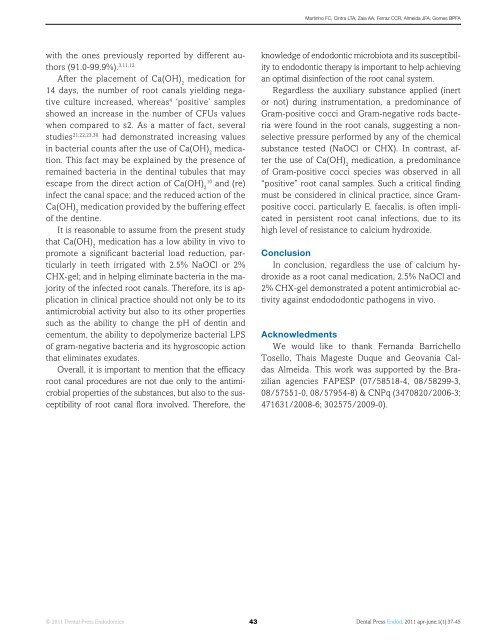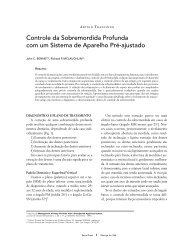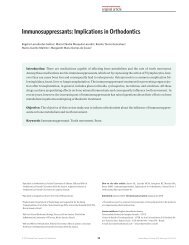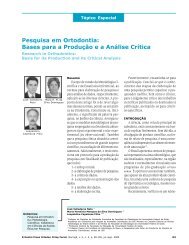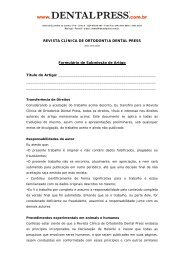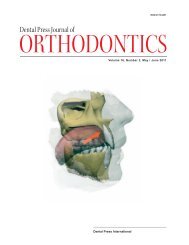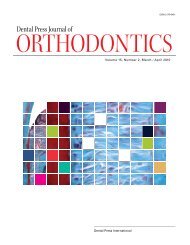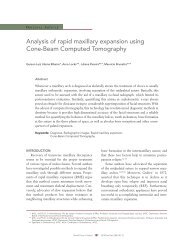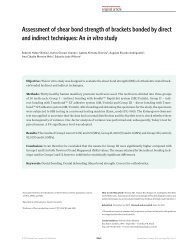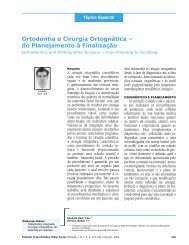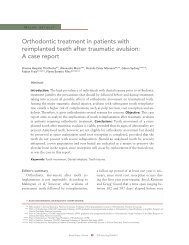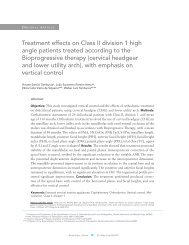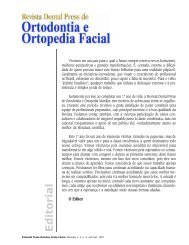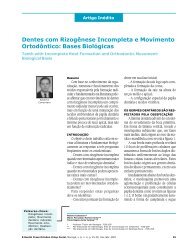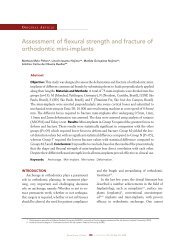Dental Press
Dental Press
Dental Press
Create successful ePaper yourself
Turn your PDF publications into a flip-book with our unique Google optimized e-Paper software.
Martinho FC, Cintra LTA, Zaia AA, Ferraz CCR, Almeida JFA, Gomes BPFA<br />
with the ones previously reported by different authors<br />
(91.0-99.9%). 3,11,12<br />
After the placement of Ca(OH) 2<br />
medication for<br />
14 days, the number of root canals yielding negative<br />
culture increased, whereas 4 ‘positive’ samples<br />
showed an increase in the number of CFUs values<br />
when compared to s2. As a matter of fact, several<br />
studies 21,22,23,30 had demonstrated increasing values<br />
in bacterial counts after the use of Ca(OH) 2<br />
medication.<br />
This fact may be explained by the presence of<br />
remained bacteria in the dentinal tubules that may<br />
escape from the direct action of Ca(OH) 2<br />
10<br />
and (re)<br />
infect the canal space; and the reduced action of the<br />
Ca(OH) 2<br />
medication provided by the buffering effect<br />
of the dentine.<br />
It is reasonable to assume from the present study<br />
that Ca(OH) 2<br />
medication has a low ability in vivo to<br />
promote a significant bacterial load reduction, particularly<br />
in teeth irrigated with 2.5% NaOCl or 2%<br />
CHX-gel; and in helping eliminate bacteria in the majority<br />
of the infected root canals. Therefore, its is application<br />
in clinical practice should not only be to its<br />
antimicrobial activity but also to its other properties<br />
such as the ability to change the pH of dentin and<br />
cementum, the ability to depolymerize bacterial LPS<br />
of gram-negative bacteria and its hygroscopic action<br />
that eliminates exudates.<br />
Overall, it is important to mention that the efficacy<br />
root canal procedures are not due only to the antimicrobial<br />
properties of the substances, but also to the susceptibility<br />
of root canal flora involved. Therefore, the<br />
knowledge of endodontic microbiota and its susceptibility<br />
to endodontic therapy is important to help achieving<br />
an optimal disinfection of the root canal system.<br />
Regardless the auxiliary substance applied (inert<br />
or not) during instrumentation, a predominance of<br />
Gram-positive cocci and Gram-negative rods bacteria<br />
were found in the root canals, suggesting a nonselective<br />
pressure performed by any of the chemical<br />
substance tested (NaOCl or CHX). In contrast, after<br />
the use of Ca(OH) 2<br />
medication, a predominance<br />
of Gram-positive cocci species was observed in all<br />
“positive” root canal samples. Such a critical finding<br />
must be considered in clinical practice, since Grampositive<br />
cocci, particularly E. faecalis, is often implicated<br />
in persistent root canal infections, due to its<br />
high level of resistance to calcium hydroxide.<br />
Conclusion<br />
In conclusion, regardless the use of calcium hydroxide<br />
as a root canal medication, 2.5% NaOCl and<br />
2% CHX-gel demonstrated a potent antimicrobial activity<br />
against endododontic pathogens in vivo.<br />
Acknowledments<br />
We would like to thank Fernanda Barrichello<br />
Tosello, Thais Mageste Duque and Geovania Caldas<br />
Almeida. This work was supported by the Brazilian<br />
agencies FAPESP (07/58518-4, 08/58299-3,<br />
08/57551-0, 08/57954-8) & CNPq (3470820/2006-3;<br />
471631/2008-6; 302575/2009-0).<br />
© 2011 <strong>Dental</strong> <strong>Press</strong> Endodontics 43<br />
<strong>Dental</strong> <strong>Press</strong> Endod. 2011 apr-june;1(1):37-45


